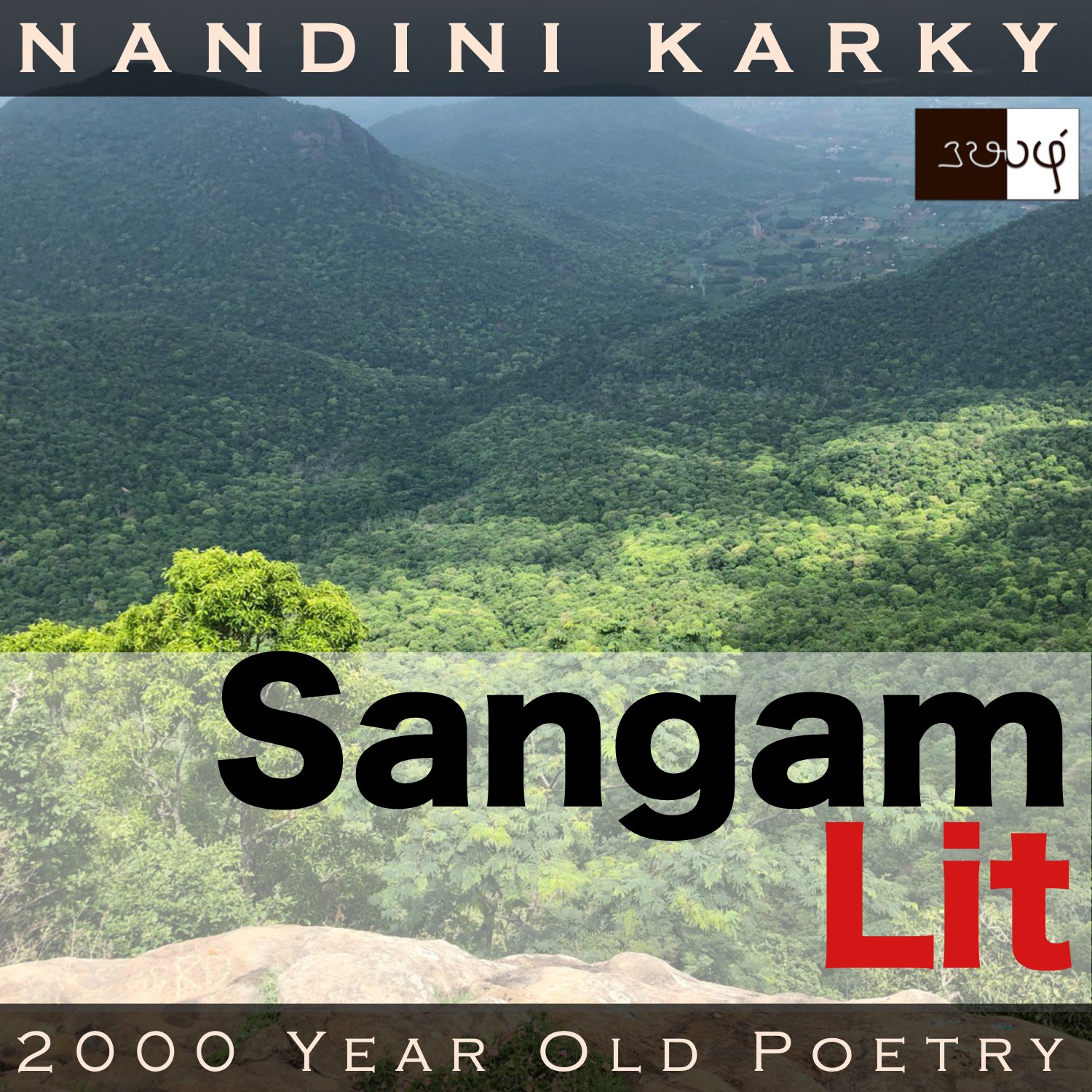Podcast: Play in new window | Download
Subscribe: Apple Podcasts | Spotify | Amazon Music | Android | iHeartRadio | TuneIn | RSS | More

In this episode, we perceive images from the mountain country portraying the intricacies of inner life, as depicted in Sangam Literary work, Natrinai 225, penned by Kabilar. The verse is set in ‘Kurinji’ or the mountainous regions and speaks in the voice of the lady to her confidante, refusing to be consoled as the man is delayed in his return to her.
முருகு உறழ் முன்பொடு கடுஞ் சினம் செருக்கிப்
பொருத யானை வெண் கோடு கடுப்ப,
வாழை ஈன்ற வை ஏந்து கொழு முகை,
மெல் இயல் மகளிர் ஓதி அன்ன
பூவொடு, துயல் வரும் மால் வரை நாடனை
இரந்தோர் உளர்கொல்-தோழி!-திருந்து இழைத்
தொய்யில் வன முலை வரி வனப்பு இழப்பப்
பசந்து எழு பருவரல் தீர,
நயந்தோர்க்கு உதவா நார் இல் மார்பே?
The verse opens with reference to the god of the hills, Murugu, and this god is compared to ‘பொருத யானை’ or a ‘battling elephant’. From the god and the elephant, we move on to ‘வாழை ஈன்ற வை ஏந்து கொழு முகை’ meaning ‘sharp and curved cluster of plantain fruits’. And then, ‘மெல் இயல் மகளிர் ஓதி’ talks about the ‘tresses of gentle-natured women’. Revealing the aesthetic sense of the ancients, appears ‘தொய்யில்’ or ‘the art of drawing intricate patterns and lines on a woman’s breasts and shoulders’; the art form referenced in Natrinai verses 29 and 39. The deadly, ancient virus attacks in ‘பசந்து எழு பருவரல்’ meaning ‘suffering caused by pining’. The verse ends with the words ‘நார் இல் மார்பே’ meaning ‘a chest lacking love’. Let’s listen closely to understand how the heart in this loveless chest beats!
The man and lady have been in a love relationship and the man parts with her in order to gather wealth for their wedding. As the man is delayed in his return, the lady suffers with anguish. When the confidante tries to console the lady, the lady says, “Like god Murugu, the elephant battles with strength, raging with immense fury. Akin to the tusk of this warring pachyderm, stands the shoots of the banana tree, those sharp and lifted cluster of buds, which sways along with flowers, which are like the tresses of gentle-natured women. Such scenes are to be found in the soaring mountain country of our lord. Did anyone go seeking the comfort of his chest? Tell me, O friend! That chest of his, sans love, that doesn’t relent to those who seek its aid and thereby, causes the disease of pining to spread and make these jewel-adorned, ‘thoyyil’-painted, line-streaked breasts lose their beauty!” With these words, the lady is giving vent to her dejection about the man’s perceived lack of compassion, as he delays in returning and seeking her hand in marriage.
Now, for the nuances hiding within! The lady starts by bringing God Murugu into the picture. He is being referenced so as to qualify the strength and fury of a raging elephant. Then, the lady turns her attention to the red-streaked tusks of such an elephant and places that as a simile for a sharp and curved plantain fruit. Here, the lady is referring to the well-known ‘செவ்வாழை’ or ‘red banana’, packed with nutritional benefits and also, having the curious quality of a lower glycemic index than the yellow banana, even though the red ones are sweeter than the other. Turning away from our modern preoccupation with food, we see how the lady equates the blood-dripping tusk of an elephant to this banana. She then adds that a cluster of these fruits sway along with the flowers, which are soft like the hair of gentle-natured women. She concludes saying such elements are to be found in the man’s mountain country but there is something more hiding in these involved similes and scenes from the hills.
Before we explore the metaphor, let’s turn our attention to an angry question put forth by the lady. Her question is, ‘did anyone go seeking the lord’s chest?’ and by this, she’s highlighting the fact that she didn’t seek the man but rather he came to her and sought to win her affections. Then, she ends by saying that indeed there seems to be no love throbbing in the heart of the man, who by his staying away, has caused the affliction of pining to spread and wreak havoc on her beautiful breasts, painted with the art of those times. Although it seems a simple moment of venting, within the metaphor, the lady packs an understanding of gender roles. It seemed to be the man’s lot then, to face with strength, the brutalities of life, while the nature of women was portrayed as something delicate like the flowers. While on the outside, the lady is lamenting on the man’s seeming lack of compassion for her, within her is an understanding that such was life then. Herein lies the light telling us that before we can change things, we need to see things as they are and just be!




Share your thoughts...